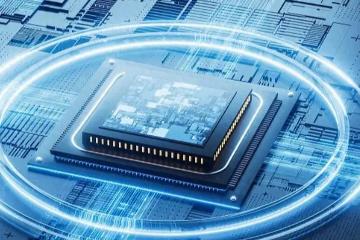Client CPU Shipments Surge 12% in Q3
Advertisements
Recent trends in the global CPU market have unveiled an intriguing narrative—one that speaks to technological advancements and market dynamics, particularly with China's burgeoning roleAccording to the latest findings from Jon Peddie Research, the third quarter of 2024 has seen a notable surge in the global CPU market, with client CPU sales showing a robust 7.8% year-on-year growth.
This report highlights a remarkable performance overall, with a quarterly growth rate of 12% for the PC CPU marketSuch data points are significant in an industry often characterized by fluctuations and competitive pressuresThe server CPU arena also reflects healthy activity, recording a 10.5% increase from the previous quarter and a 2% uptick compared to the same period last yearHowever, it's noteworthy that AMD's market share has dipped to 24.1%, indicative of an evolving landscape.
The third quarter typically brings an upswing in sales, and this trend continues as the shipments of integrated graphics processing units (iGPUs) across all client platforms rose 7% sequentially and 6% year-on-year
Such growth signals a vibrant demand for both standalone CPUs and integrated solutions, thus showcasing the multifaceted nature of consumer preferences.
Jon Peddie Research also attributes a significant portion of this growth to Lenovo, a key player in the Chinese marketThe boom in China's PC CPU demand underscores the vital role of local companies in driving global trendsDespite some volatility in the client PC market, the sharp increase in Q3 sales suggests a positive turn, amidst broader inquiries regarding the impact of Artificial Intelligence (AI) PCs on consumer habits.
In a related update, Lenovo showcased its third financial quarter results for the fiscal year 2024/25, revealing a commanding revenue of 127.9 billion yuan, representing a year-on-year increase of 23.87% alongside a quarterly rise of 15.56%. The company also reported a net profit nearing 2.9 billion yuan—a noteworthy 48% increase from the previous year.
Throughout this period, Lenovo's PC segment demonstrated commendable resilience, outpacing market averages by 4.6 percentage points in terms of shipments, capturing nearly 24% of the global market share
- Common Psychological Pitfalls for Investors.
- The Dilemma of Automotive LiDAR
- Bitcoin in 2024: Global Regulation Takes Shape
- Tongcheng Targets International Expansion After $8B Valuation
- Who Will Power the AI Boom?
This positions Lenovo firmly ahead of its closest competitor, with operational profit margins that maintain a competitive edge in an often cutthroat industry environment.
On the technological front, Microsoft has recently unveiled a high-performance computing (HPC) Azure virtual machine, powered by a custom AMD CPU that was previously hinted at as the MI300CThis new HBv series Azure VM focuses on delivering remarkable memory bandwidth—an essential specification in the realm of HPC, which Microsoft identifies as the “largest HPC bottleneck.” The technology used showcases AMD's strategy of collaboration and bespoke development tailored for Microsoft’s infrastructure.
The latest HBv5 VM distinguishes itself with four custom AMD CPUs utilizing High Bandwidth Memory (HBM3), typically reserved for the latest generation of data center-grade GPUs
The performance is nothing short of spectacular, with these VMs exhibiting a bandwidth capacity of 6.9TB/s—a marked improvement over their predecessorsComparatively, the HBv5 VMs are nearly nine times faster than those using Genoa-X CPUs in the HBv4 VM and boast a staggering 20 times the speed of the Milan-X chips found in the HBv3 VM.
The architectural innovation does not stop there; each HBv5 VM is provisioned with four custom AMD CPUs, delivering a staggering 450GB of HBM3 and 352 Zen 4 cores clocked up to 4GHz, doubling the bandwidth available in standard EPYC CPUsHowever, it's important to note that simultaneous multi-threading (SMT) has been disabled within these configurations, spotlighting the VM’s focus on maximizing throughput and efficiency over multithreading capabilities.
The design of these CPUs involves intricacies such as potentially utilizing either Zen 4 or Zen 4c core designs, tailored for specific workloads
Custom configurations can lead to 96 functional cores while reserving eight for managing virtual machine operations likely acting as orchestrators or hypervisor systemsAlthough termed "custom," there lies a speculation that these CPUs may closely resemble the much-discussed MI300C chip designed for powerful APU performance.
Despite anecdotal information claiming this CPU’s specifications largely echo those of last year's MI300A APU—with the core clock rates being quite similar—the uniqueness of the CPU remains in its association with Microsoft’s Azure serviceIt's reported that the CPU is distinctively designed for Azure environments, reinforcing Microsoft's strategy to provide exclusive performance enhancements to its cloud services.
According to AMD memory engineer Phil Park, the transition of what was once considered for public sale to an exclusive Azure offering aligns with market demands and AMD's strategic focus

The realities of production versus consumer availability often dictate the path forward for such bespoke technologies.
The evolving landscape indicates a strong emphasis on architectures capable of meeting the burgeoning needs of high-performance computingAs noted in discussions regarding previous developments in CPUs equipped with HBM, such advancements are critical to future-proofing cloud-based infrastructures.
Looking towards the future, with substantial shifts happening within AMD’s strategy and the success of Microsoft’s Azure deployments, one might expect these collaborative efforts between tech giants to continue driving innovationThe needs of enterprise clients requiring increasingly powerful processing capabilities will shape the future of CPU architecture, underscoring the critical interaction between technology development and market application.
Leave a Reply